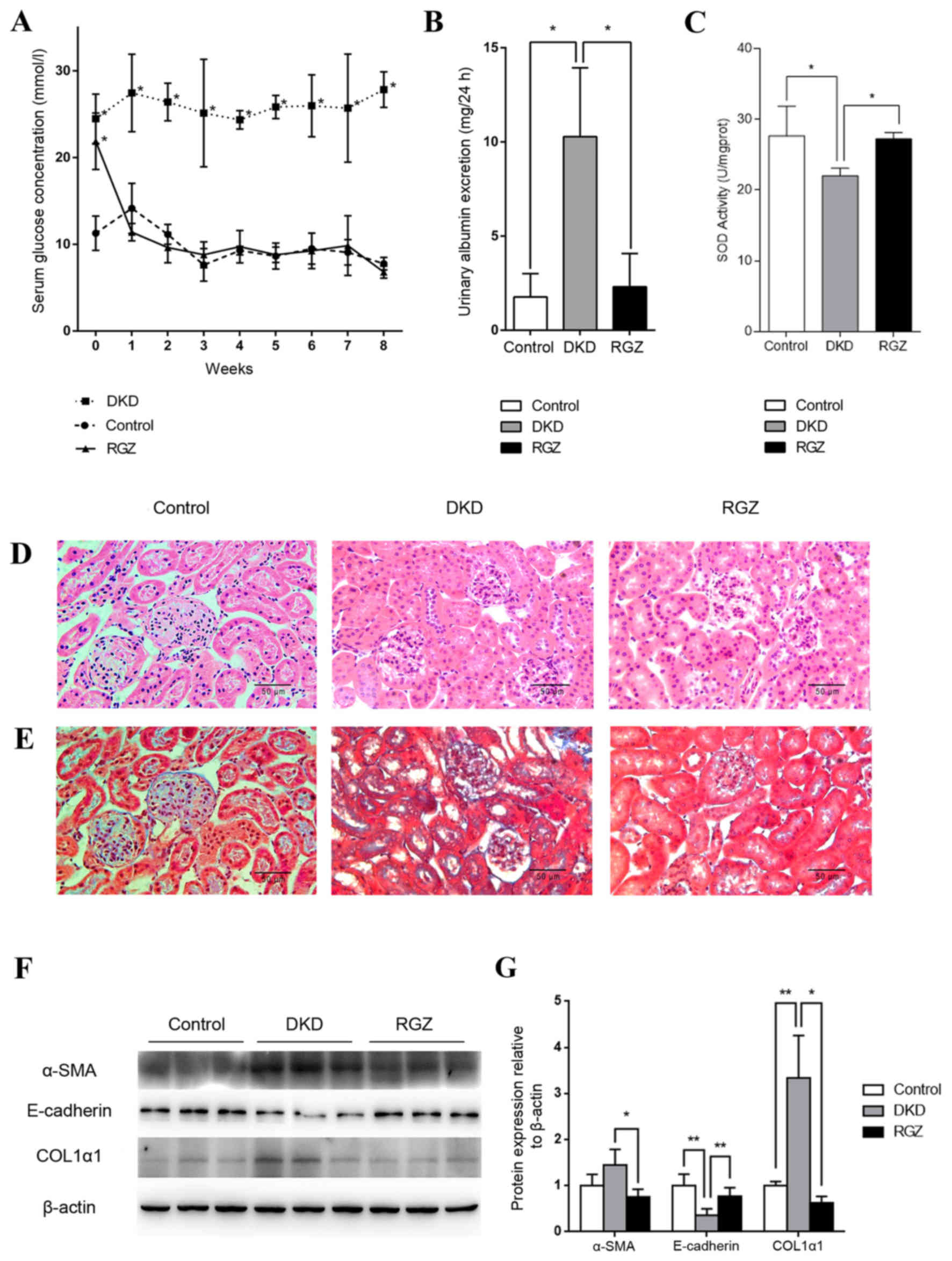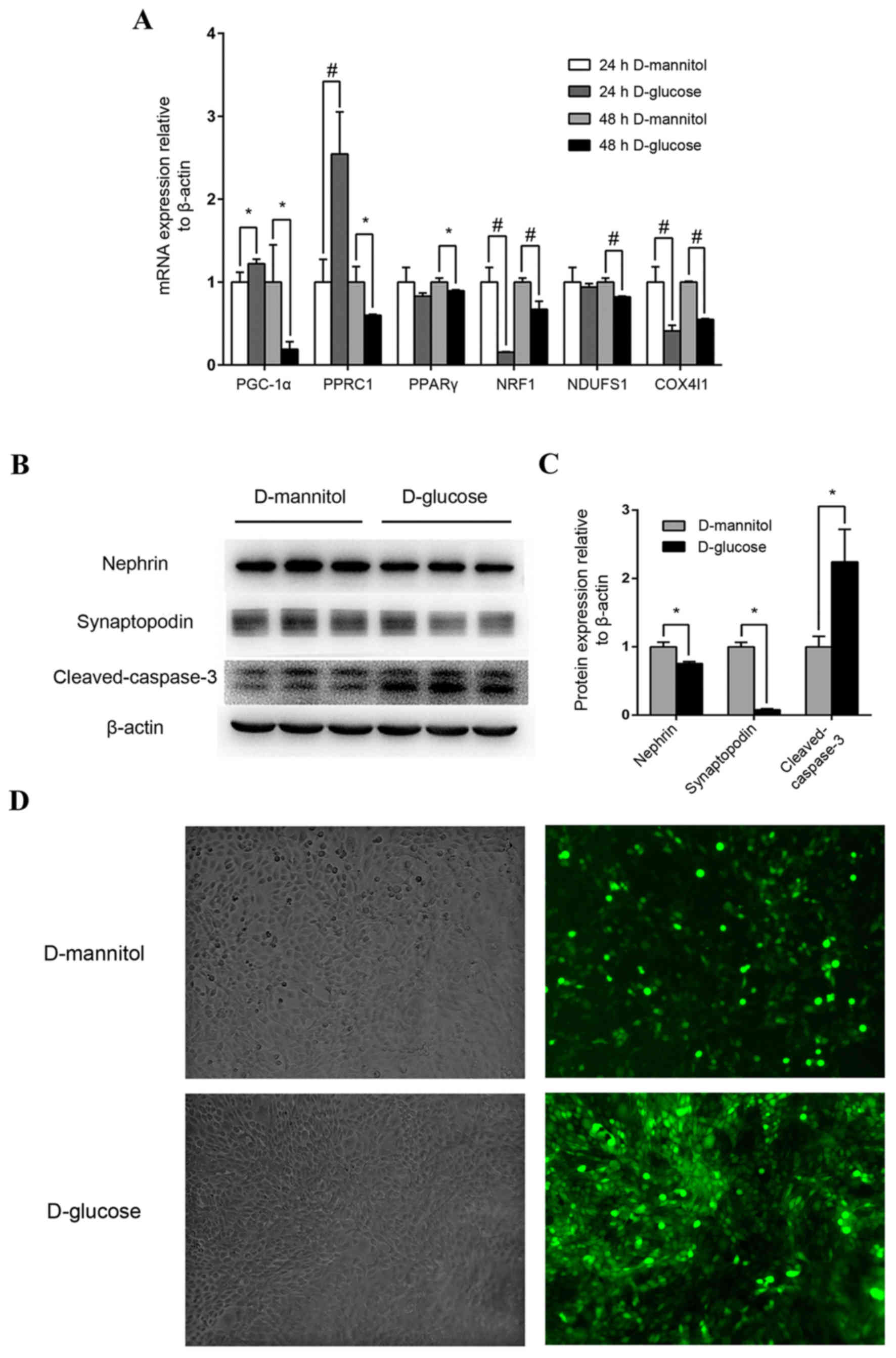|
1
|
Collins AJ, Foley RN, Chavers B,
Gilbertson D, Herzog C, Johansen K, Kasiske B, Kutner N, Liu J, St
Peter W, et al: United States Renal Data System 2011 Annual Data
Report: Atlas of chronic kidney disease & end-stage renal
disease in the United States. Am J Kidney Dis. 59 1 Suppl 1:(A7):
e1–e420. 2012.
|
|
2
|
Zhang L, Long J, Jiang W, Shi Y, He X,
Zhou Z, Li Y, Yeung RO, Wang J, Matsushita K, et al: Trends in
chronic kidney disease in China. N Engl J Med. 375:905–906. 2016.
View Article : Google Scholar : PubMed/NCBI
|
|
3
|
Kanwar YS, Wada J, Sun L, Xie P, Wallner
EI, Chen S, Chugh S and Danesh FR: Diabetic nephropathy: Mechanisms
of renal disease progression. Exp Biol Med (Maywood). 233:4–11.
2008. View Article : Google Scholar : PubMed/NCBI
|
|
4
|
Abe Y, Sakairi T, Beeson C and Kopp JB:
TGF-β1 stimulates mitochondrial oxidative phosphorylation and
generation of reactive oxygen species in cultured mouse podocytes,
mediated in part by the mTOR pathway. Am J Renal Physiol.
305:F1477–F1490. 2013. View Article : Google Scholar
|
|
5
|
Casalena G, Daehn I and Bottinger E:
Transforming growth factor-beta, bioenergetics, and mitochondria in
renal disease. Semin Nephrol. 32:295–303. 2012. View Article : Google Scholar : PubMed/NCBI
|
|
6
|
Liu C and Lin JD: PGC-1 coactivators in
the control of energy metabolism. Acta Bioch Bioph Sin (Shanghai).
43:248–257. 2011. View Article : Google Scholar
|
|
7
|
Handschin C and Spiegelman BM: Peroxisome
proliferator-activated receptor gamma coactivator 1 coactivators,
energy homeostasis, and metabolism. Endocr Rev. 27:728–735. 2007.
View Article : Google Scholar
|
|
8
|
Andersson U and Scarpulla RC:
Pgc-1-related coactivator, a novel, serum-inducible coactivator of
nuclear respiratory factor 1-dependent transcription in mammalian
cells. Mol Cell Biol. 21:3738–3749. 2001. View Article : Google Scholar : PubMed/NCBI
|
|
9
|
Hickey FB, Corcoran JB, Docherty NG,
Griffin B, Bhreathnach U, Furlong F, Martin F, Godson C and Murphy
M: IHG-1 promotes mitochondrial biogenesis by stabilizing PGC-1α. J
Am Soc Nephrol. 22:1475–1485. 2011. View Article : Google Scholar : PubMed/NCBI
|
|
10
|
Tran M and Parikh SM: Mitochondrial
biogenesis in the acutely injured kidney. Nephron Clin Pract.
127:42–45. 2014. View Article : Google Scholar : PubMed/NCBI
|
|
11
|
Marmolino D, Manto M, Acquaviva F, Vergara
P, Ravella A, Monticelli A and Pandolfo M: PGC-1alpha
down-regulation affects the antioxidant response in Friedreich's
ataxia. PLoS One. 5:e100252010. View Article : Google Scholar : PubMed/NCBI
|
|
12
|
Miglio G, Rosa AC, Rattazzi L, Collino M,
Lombardi G and Fantozzi R: PPARgamma stimulation promotes
mitochondrial biogenesis and prevents glucose deprivation-induced
neuronal cell loss. Neurochem Int. 55:496–504. 2009. View Article : Google Scholar : PubMed/NCBI
|
|
13
|
Wenz T, Diaz F, Spiegelman BM and Moraes
CT: Activation of the PPAR/PGC-1alpha pathway prevents a
bioenergetic deficit and effectively improves a mitochondrial
myopathy phenotype. Cell Metab. 8:249–256. 2008. View Article : Google Scholar : PubMed/NCBI
|
|
14
|
Jin Y, Ratnam K, Chuang PY, Fan Y, Zhong
Y, Dai Y, Mazloom AR, Chen EY, D'Agati V, Xiong H, et al: A systems
approach identifies HIPK2 as a key regulator of kidney fibrosis.
Nat Med. 18:580–588. 2012. View
Article : Google Scholar : PubMed/NCBI
|
|
15
|
Zhang Z, Zhang H, Li B, Meng X, Wang J,
Zhang Y, Yao S, Ma Q, Jin L, Yang J, et al: Berberine activates
thermogenesis in white and brown adipose tissue. Nat Commun.
5:54932014. View Article : Google Scholar : PubMed/NCBI
|
|
16
|
Livak KJ and Schmittgen TD: Analysis of
relative gene expression data using real-time quantitative PCR and
the 2(-Delta Delta C(T)) method. Methods. 25:402–408. 2001.
View Article : Google Scholar : PubMed/NCBI
|
|
17
|
Weinberg JM: Mitochondrial biogenesis in
kidney disease. J Am Soc Nephrol. 22:431–436. 2011. View Article : Google Scholar : PubMed/NCBI
|
|
18
|
Ishimoto Y and Inagi R: Mitochondria: A
therapeutic target in acute kidney injury. Nephrol Dial Transpl.
31:1062–1069. 2016. View Article : Google Scholar
|
|
19
|
Ruan X, Zheng F and Guan Y: PPARs and the
kidney in metabolic syndrome. Am J Physiol Renal Physiol.
294:F1032–F1047. 2008. View Article : Google Scholar : PubMed/NCBI
|
|
20
|
Wang XX, Jiang T and Levi M: Nuclear
hormone receptors in diabetic nephropathy. Nat Rev Nephrol.
6:342–351. 2010. View Article : Google Scholar : PubMed/NCBI
|
|
21
|
Sharma K, McCue P and Dunn SR: Diabetic
kidney disease in the db/db mouse. Am J Physiol Renal Physiol.
284:F1138–F1144. 2003. View Article : Google Scholar : PubMed/NCBI
|
|
22
|
St-Pierre J, Drori S, Uldry M, Silvaggi
JM, Rhee J, Jäger S, Handschin C, Zheng K, Lin J, Yang W, et al:
Suppression of reactive oxygen species and neurodegeneration by the
PGC-1 transcriptional coactivators. Cell. 127:397–408. 2006.
View Article : Google Scholar : PubMed/NCBI
|
|
23
|
Haden DW, Suliman HB, Carraway MS,
Welty-Wolf KE, Ali AS, Shitara H, Yonekawa H and Piantadosi CA:
Mitochondrial biogenesis restores oxidative metabolism during
Staphylococcus aureus sepsis. Am J Resp Crit Care. 176:768–777.
2007. View Article : Google Scholar
|
|
24
|
Lambert AJ and Brand MD: Reactive oxygen
species production by mitochondria. Methods Mol Biol. 554:165–181.
2009. View Article : Google Scholar : PubMed/NCBI
|
|
25
|
Coughlan MT and Sharma K: Challenging the
dogma of mitochondrial reactive oxygen species overproduction in
diabetic kidney disease. Kidney Int. 90:272–279. 2016. View Article : Google Scholar : PubMed/NCBI
|


















